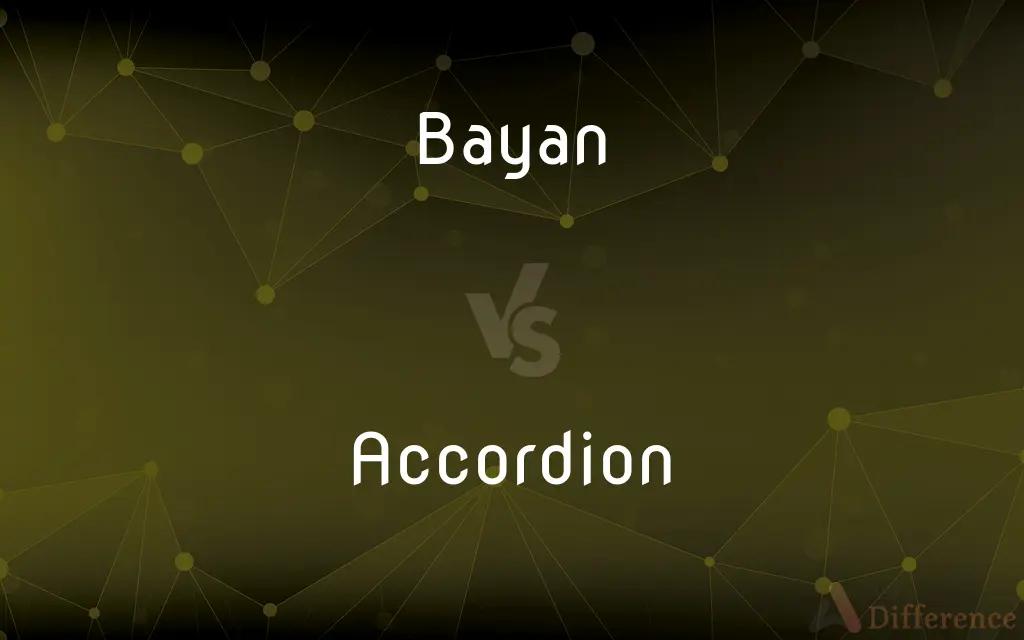Bayan vs. Accordion — What's the Difference?
Edited by Tayyaba Rehman — By Urooj Arif — Updated on April 5, 2024
Bayan, a type of button accordion from Russia, is known for its deep bass sound, while the accordion, popular in Western music, features piano-like keys for melody and buttons for bass.

Difference Between Bayan and Accordion
Table of Contents
ADVERTISEMENT
Key Differences
The bayan is a type of chromatic button accordion developed in Russia, distinguished by its button keyboard and a rich, deep bass sound. This instrument is especially valued in classical and folk music for its wide range of dynamics and expressive capabilities. The accordion, on the other hand, is more commonly associated with Western music and comes in various forms, including the piano accordion, which features piano-style keys for the right hand and bass buttons for the left hand.
One of the main differences between the bayan and the accordion lies in their construction and sound production. The bayan often has a larger body and more reeds, contributing to its powerful sound and wide dynamic range. In contrast, the accordion is known for its versatility and can produce a wide variety of tones, from bright and piercing to soft and mellow, depending on the model and playing style.
The bayan's button keyboard allows for faster and more complex passages, making it well-suited for classical and traditional Russian music. Accordion players, however, benefit from the intuitive layout of the piano keys, which is particularly advantageous for those with piano playing experience or those performing music with a wide range of chords and melodies.
In terms of repertoire and playing technique, bayan players often engage in classical music arrangements and original compositions that require advanced technique and a deep understanding of the instrument's capabilities. Accordionists, while also capable of performing complex music, are more often found in folk, jazz, and popular music genres, where the instrument's expressive qualities are used to complement a wide range of musical styles.
The choice between bayan and accordion often comes down to personal preference, musical background, and the specific requirements of the repertoire being performed. Both instruments have their unique characteristics and can provide a rich musical experience, whether in solo performances, chamber music, or larger ensembles.
ADVERTISEMENT
Comparison Chart
Origin
Russia
Europe (Italy, Germany)
Keyboard Type
Buttons for both melody and bass.
Piano keys for melody and buttons for bass (piano accordion).
Sound
Deep, rich bass; wide dynamic range.
Versatile, can range from bright to soft.
Construction
Larger body, more reeds.
Varies, generally smaller than bayan.
Preferred Music
Classical, Russian folk.
Folk, jazz, pop, Western classical.
Technique
Suited for fast, complex passages.
Intuitive for those with piano background; versatile.
Repertoire
Classical arrangements, Russian compositions.
Broad, including folk, jazz, pop.
Compare with Definitions
Bayan
Deep Bass Sound.
The bayan's deep bass sound enriches the orchestra's lower register.
Accordion
Wide Range of Chords and Melodies.
He explored a wide range of chords and melodies on the accordion, captivating the audience.
Bayan
Classical and Folk Music.
The bayan is celebrated in classical and Russian folk music circles for its expressive capabilities.
Accordion
Versatile Tones.
The accordion added versatile tones, from bright polkas to mellow ballads, to the concert.
Bayan
Large Body and More Reeds.
Its large body and additional reeds give the bayan a powerful presence in any ensemble.
Accordion
Piano-Style Keys.
Her transition from piano to accordion was seamless, thanks to the piano-style keys.
Bayan
Button Keyboard.
He played a complex melody on the bayan's button keyboard with remarkable speed.
Accordion
Folk and Jazz Music.
The accordion is a staple in folk and jazz music, adding a lively or soulful touch to performances.
Bayan
Rich Dynamics.
The bayan's rich dynamics were showcased in the solo performance, from whisper-soft to thunderously loud.
Accordion
Intuitive Layout.
The intuitive layout of the accordion makes it accessible for musicians of all levels.
Bayan
A type of chromatic button accordion developed in Russia in the early 20th century.
Accordion
Accordions (from 19th-century German Akkordeon, from Akkord—"musical chord, concord of sounds") are a family of box-shaped musical instruments of the bellows-driven free-reed aerophone type, colloquially referred to as a squeezebox. A person who plays the accordion is called an accordionist.
Bayan
(Islam) A lecture.
Accordion
A musical instrument played by stretching and squeezing with the hands to work a central bellows that blows air over metal reeds, the melody and chords being sounded by buttons or keys.
Her five brothers and sisters were singing to the accompaniment of an accordion
An accordion player
Accordion
A portable wind instrument with a small keyboard and free metal reeds that sound when air is forced past them by pleated bellows operated by the player.
Accordion
Having folds or bends like the bellows of an accordion
Accordion pleats.
Accordion blinds.
Accordion
A box-shaped musical instrument with means of keys and buttons, whose tones are generated by play of the wind from a squeezed bellows upon free metallic reeds.
Accordion
(GUI) A vertical list of items that can be individually expanded and collapsed to reveal their contents.
Accordion
(figurative) A set of items (concepts, links, or otherwise) that can be packed and unpacked cognitively, or their representation as a set of virtual object. en
Accordion
To fold up, in the manner of an accordion
Accordion
A small, portable, keyed wind instrument, whose tones are generated by play of the wind upon free metallic reeds.
Accordion
A portable box-shaped free-reed instrument; the reeds are made to vibrate by air from the bellows controlled by the player
Accordion
Arranged in parallel folds;
Plicate leaves
Common Curiosities
What makes the bayan unique in its sound?
The bayan's unique sound comes from its larger body, more reeds, and the way it produces a deep, rich bass.
How does the accordion differ from the bayan?
The accordion often features piano-style keys for melodies and is known for its versatility across many musical genres, unlike the button-keyed bayan.
Are there different sizes of bayans and accordions?
Yes, both instruments come in various sizes, affecting their sound, volume, and the number of keys or buttons.
What genres of music is the bayan commonly used in?
The bayan is commonly used in classical and traditional Russian folk music.
Can the accordion be used in orchestral music?
Yes, the accordion can be used in orchestral music, adding unique textures and sounds.
What is the learning curve like for the accordion?
The learning curve can vary, with piano accordions generally being more accessible for those with piano experience.
What is a bayan?
A bayan is a Russian type of chromatic button accordion known for its deep bass sound and button keyboard.
Why might a musician choose a bayan over an accordion?
A musician might prefer the bayan for its deep, rich sound and suitability for complex classical and folk music.
Can accordionists play classical music?
Yes, accordionists can play classical music, especially on piano accordions, which accommodate a wide range of chords and melodies.
Is the accordion suitable for beginners?
Yes, the accordion, especially models with piano-style keys, is suitable for beginners due to its intuitive layout.
How does the button keyboard of a bayan affect playability?
The button keyboard allows for faster, more complex passages, making it ideal for intricate musical pieces.
What is the range of music that can be played on an accordion?
Accordions can play a wide range of music, from folk and jazz to pop and classical pieces.
Why is the accordion popular in folk music?
The accordion's versatility and expressive capabilities make it a favorite in folk music, where it adds a lively or emotional dimension.
How do the playing techniques of bayan and accordion differ?
The playing techniques differ mainly in the use of buttons versus piano keys, affecting the approach to melody and harmony.
What role does the bayan play in an ensemble?
In an ensemble, the bayan often provides a strong bass foundation and enhances the overall sound with its dynamic range.
Share Your Discovery

Previous Comparison
Superhero vs. Vigilante
Next Comparison
Extract vs. RetrieveAuthor Spotlight
Written by
Urooj ArifUrooj is a skilled content writer at Ask Difference, known for her exceptional ability to simplify complex topics into engaging and informative content. With a passion for research and a flair for clear, concise writing, she consistently delivers articles that resonate with our diverse audience.
Edited by
Tayyaba RehmanTayyaba Rehman is a distinguished writer, currently serving as a primary contributor to askdifference.com. As a researcher in semantics and etymology, Tayyaba's passion for the complexity of languages and their distinctions has found a perfect home on the platform. Tayyaba delves into the intricacies of language, distinguishing between commonly confused words and phrases, thereby providing clarity for readers worldwide.














































